Laser weapons for river tanks
The reason for this unexpected turn is quite obvious: by the middle of the 1960-s, the remaining ships of the 1124, 1125 and 191-M projects were technically and morally outdated, and by the beginning of the 1970-s. and the Navy and the naval units of the border troops could even be left without the much-needed armored boats. The rapid deterioration of relations with China played a significant role here - on the Amur it was necessary to have its own river forces.
According to the requirements of the tactical and technical assignment (TTZ), the river AKA of the 1204 project was designed to meet the tasks of guarding the rivers and lakes, destroying the river vessels and battle boats of the enemy, assisting ground forces with artillery and machine guns and carrying ammunition during crossings and actions in river basins, as well as for actions in coastal areas of the seas. From this followed a simple conclusion: the new artillery boat was designed to perform the same tasks as the armored boats of the 1124, 1125 and 191-M projects. In addition, for the project 1204 stipulated the possibility of its use in the coastal shallow areas of the seas. For this (unlike the “prototype” pr. 192) the boat was made smooth-decked.
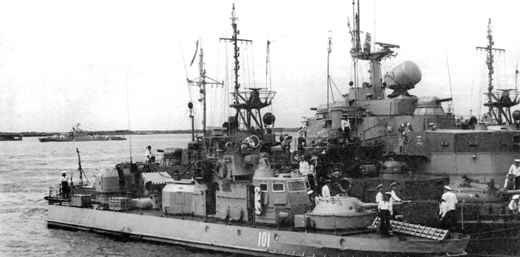
The displacement amounted to 71 ton, the power of the two-shaft diesel GEM was 2400 hp, the speed of the 23-24 node. The reservation of the AKA was much weaker than that of its predecessor, which was due to the limited displacement. And the requirements for seaworthiness and habitability were increased, as the conditions of service on the armored boats of previous projects were very difficult.
As for the main armament of the designed artillery boat, the designers first chose the 90-mm gun of the new floating tank Object 906 (the production of the MK-85 tower has long been discontinued). However, the tank was not adopted for service, because of which it was necessary to use the turret of the serial tank PT-76B with a weaker 76,2 mm gun.
As an anti-aircraft weapon in the stern of the boat was placed a 14,5-mm machine gun 2M-6, although with the advent of reactive aviation its value as a means of air defense was very conditional. The project also provided for equipping the ship with Malyutka anti-tank missiles, but without stabilizing the sight, firing such missiles from a rocket-prone carrier was impossible and this idea was abandoned, as well as the placement of a 120-mm mortar behind the wheelhouse.
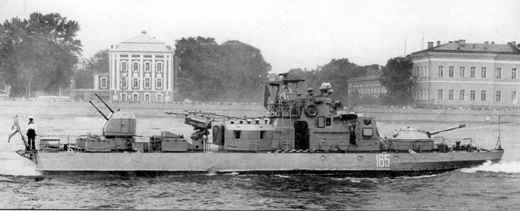
The head boat of the 1204 project (Shmel class - as we see, the western designation coincided with the real code) was built in Kerch at the Gulf plant in 1967 year. In total, 1967 AKA was built from 1974 to 118 in Kerch, Nikolaev and Leningrad. Of these, 56 boats were part of the Navy, and 62 boats were transferred to border guards. By the middle of 1970's. new AKA completely replaced the remaining boats pr.191-M. During the service, changes were made to the 1204 project: the 2-6 machine-gun installation was replaced with the 25-mm 2-3M cannon gun;
Later in the stern they began to install the BM-14-17 jet launcher with 17 guides, apparently drawing on the experience of using the M-8-M and M-13-M installations on World War II, 1124 and 1125, during the Great Patriotic War. The full displacement of the upgraded boats reached 77 tons.
In 1984-1985, the USSR handed over 4 boats of the 1204 project to Kampuchea, which were used on the Mekong River against the Khmer Rouge gangs. After the collapse of the USSR, 6 boats went to Ukraine, 4 - to Abkhazia and 6 - to Uzbekistan. At present, no more than three such boats are left in the maritime units of the Federal Border Guard Service of Russia.
In 1967, the development of the river small artillery ship (MAC) began, and in fact the river monitor of the 1208 project (code "Slepen") began. Of course, this was not a classic monitor of the Second World War, but as we can see, in the nuclear-missile era that began, work on this class of ships was resumed in parallel with the BKA. The design was delayed because there was no single view on the armament and protection of the ship in the new conditions. Nevertheless, in the final version, two tank turrets with 100-mm guns, borrowed from the T-55 tank, were selected as the main armament. In addition, two 30-mm six-barrel AK-630 automatic rifles with the Vympel control radar, Strela-2M-type portable anti-aircraft missile systems (MANPADS), two 12.7-mm machine guns, two 30-mm Grenade Launcher BP-30 Flame "and 140-mm rocket launcher PK-121М" Snow ".
The 1208 project had a traditional low side for monitors (to reduce the side area being affected), but a large number of weapons and combat posts led to the fact that the volume of the originally received corps was clearly insufficient to accommodate them. Therefore, in the end, the ship received a huge add-on and barbets of the tower compartments protruding above the deck. Reservations were used to protect the main command post, ammunition cellars and sides. Full displacement reached 447 tons, three-shaft diesel power plant with 11400 horsepower. allowed to reach speeds up to 23 nodes. Seaworthiness was provided such that the ship could operate both on the rivers and lakes, and in coastal sea areas.
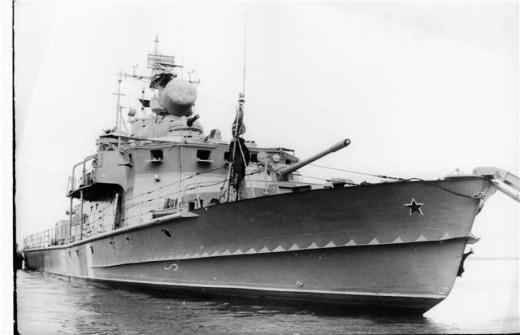
The main MAK pr. 1208 (Yaz class) was built at the Khabarovsk plant and was commissioned in the 1975 year. The entire series of 11 units was built before the 1985 year, with three ships being transferred to the naval units of the border troops, and the rest to the Navy. One ship, the MAK-11, was built according to 12081 Ave. with the installation of the Bastion-K anti-tank missile system, similar to those installed on modernized T-55AM tanks (the rocket was launched through the barrel of the gun and controlled by a laser beam). Subsequently, after the collapse of the USSR, when in 1994, the connection of the river ships of the Navy on the Amur River finally ceased to exist, all the remaining ships were transferred to the border guards. Currently in service in the Far East remains the only ship of the project 1208.
While the head MAC was built, 1208, on the basis of its technical solutions, Zelenodolsk PKB began designing a border river patrol ship, 1248 av. (The Mosquito cipher, western designation Vosh class). Reservations have remained the same, and the displacement (223 tons) and weapons cut by half. Only the AK-630 complex was replaced with a lightweight AK-306 with manual control from the sighting column. Three diesel 1100 HP allowed to develop the full speed of 17,5 nodes. The lead ship was commissioned in the 1979 year, and the entire series of 11 units was built by the 1984 year.
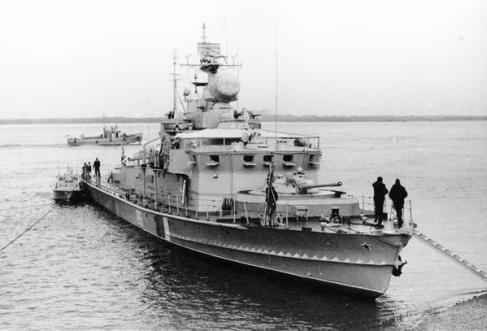
The Amur border guards project 1248 quite satisfied, as habitability, and weapons and seaworthiness. If we consider it in the context of this review, then, in fact, it was a large armored trooper. To date, 7 of such ships have remained in the ranks in the Far East.
In addition, in Khabarovsk in 1979-84 the 1248 border patrol ships of the 8 project (Piyavka class) with a displacement of 1249 tons were built in the 229 avenue. They were adapted to control the border forces and could perform the functions of a moving headquarters.
The armament of these ships included only MANPADS, one 30-mm automatic and one 30-mm automatic grenade launcher. The main power plant is the same as on pr.1248. Now these ships are part of the Amur flotilla.
Another interesting detail: in the presentation of the FSUE "NPO Astrophysics" it is reported that in 1986, "Acquilon" was accepted for joint maintenance - a complex of laser countermeasures to optical-electronic means that are part of the coastal defense of a potential enemy. As a platform for the placement of "Aquilon" just considered "river tanks". We managed to install such a laser countering system only on one ship, which received the designation "12081 project".
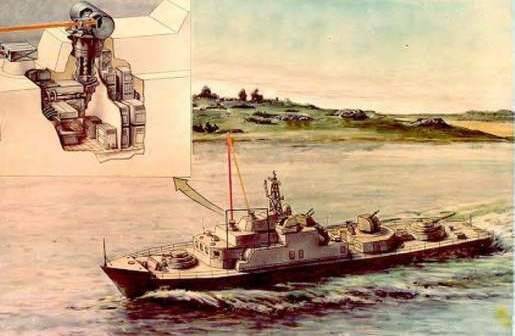
Unfortunately, the collapse of the Soviet Union and the long economic crisis put an end to this promising direction.
Information